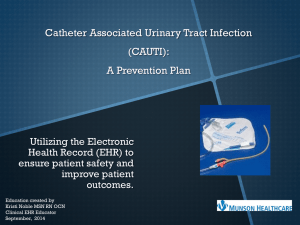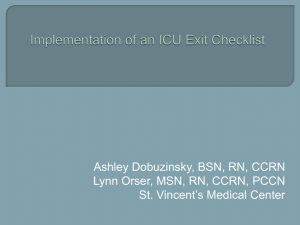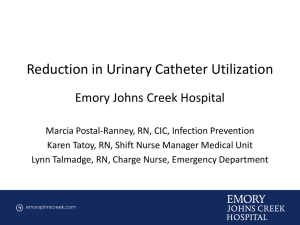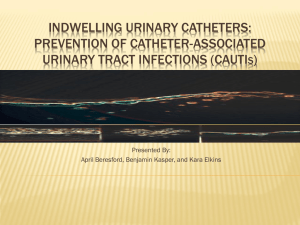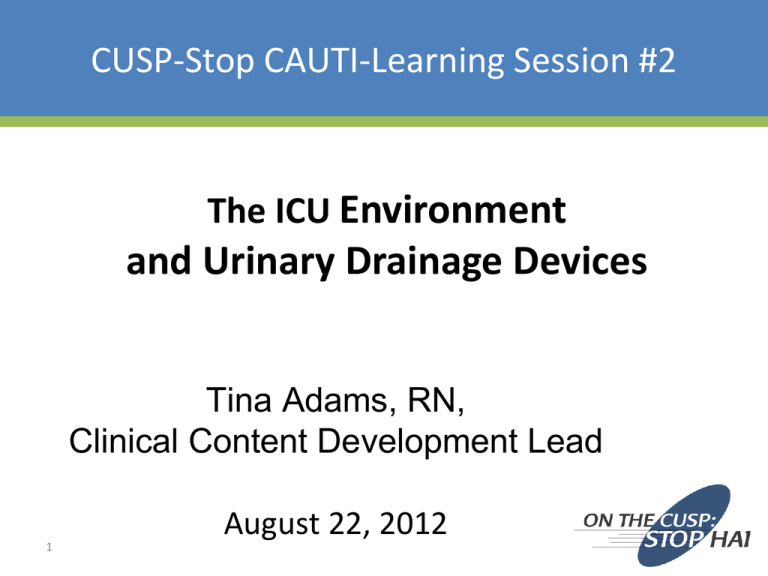
CUSP-Stop CAUTI-Learning Session #2
The ICU Environment
and Urinary Drainage Devices
Tina Adams, RN,
Clinical Content Development Lead
1
August 22, 2012
Objectives:
1. Discuss incidence of urinary drainage device use
and CAUTI in ICUs
2. State the HIPAC/CDC indications for urinary
drainage device use
3. List 3 insertion best practices
4. List 3 maintenance best practices
5. Describe systems to increase the earlier
removal of urinary catheters (UC) in ICU
2
CAUTI rate=outcome data
# of CA-SUTIs in a unit in a month
x1000
# of Catheter Days in a unit in a month
Signs and Symptoms of UTI:
+ Urine culture with uro-pathogen
Fever > 38 degrees C
Urgency
Frequency
Dysuria, pyuria (> 10 WBC unspun), +LE or Nitrate
Suprapubic tenderness
Costovertebral angle pain or tenderness
3
Rate of CAUTI in ICUs:
ICU type:
No. of location
CA-UTI
UC days
Rate
23
115
24,324
4.7
67
470
192,002
2.4
110
436
232,454
1.9
Neuro-ICU
12
84
27,681
3.0
Neuro-Surg ICU
45
446
110,797
4.0
SICU-teaching
59
471
157,384
3.0
SICU-All other
53
182
118,919
1.5
78
127
57,420
2.2
Burn
MICU-teaching
Medical-All other
PICU-Medical/ Surgical
NHSN Report, Data Summary for 2010, Device-associated Module
Uro-pathogen microorganisms:
•
•
•
•
•
•
•
•
5
Gram-negative bacilli
Staphylococcus spp.
yeasts
beta-hemolytic Streptococcus spp.
Enterococcus spp.
G. vaginalis,
Aerococcus urinae,
Corynebacterium (urease positive)
Device Utilization Ratio/DUR=process data
# of catheter days=catheter prevalence
# of patient days
ICU’s catheter utilization ratio:
(50 catheter days ÷ 100 patient days)=0.5
50% of ICU’s patient days are days in which patients
are at risk of CAUTI!
6
Rate of UC use in ICU:
ICU type:
No. of locations
Mean UC utilization ratio:
Burn
23
0.51
MICU-teaching
67
0.73
Medical-All other
110
0.65
Neuro-ICU
12
0.82
Neuro-Surg ICU
45
0.74
SICU-teaching
59
0.76
SICU-All other
53
0.78
Peds-Med/ Surg. ICU
77
0.26
NHSN Report, Data Summary for 2010, Device-associated Module
CAUTI Prevalence, Incidence
•
•
•
•
•
•
Most common site of HAI, ~ 30-40%
Estimated >560,000 per year
80% of HAI-UTI attributable to catheter
15-20% patients in hospitals have urethral catheter
Most catheterized for 2-4 days, longer
Incidence of bacteriuria associated with indwelling
cath is 3-8% per day
CDC: http://cdc.gov/HAI/pdfs/toolkits/CAUTItoolkit_3_10.pdf
8
What’s the problem?
• 15% of HAI of the bloodstream are attributable to
UTI
• 13,000 attributable deaths per year
• Increased length of stay by 2-4 days
• Increased cost $0.4-0.5 billion annually in the US
CDC: http://cdc.gov/HAI/pdfs/toolkits/CAUTItoolkit_3_10.pdf
9
CMS- payment rule changes:
• Hospital-Acquired Conditions (HAC)
– HAI-CAUTI not reimbursed as of October 2008
• Present on Admission (POA):
– Does your unit routinely order/obtain urine
cultures when UC’d patients admitted?
– Do not obtain an admission urine culture UNLESS
the patient has signs and symptoms of UTI
– Antibiotic stewardship
10
Complications related to UC:
• Infection:
– Urinary tract infection (bladder)
– Acute pyelonephritis (kidney)
– Secondary bacteremia/sepsis(blood)
– Late onset: osteomyelitis (bone) and meningitis
(brain)
11
Complications related to UC con’t:
• Adverse outcomes:
– Increased mortality
– Obstructions form to urine flow
– Selection for multi-drug resistant organisms
– Prostatitis and orchitis
12
Organisms that cause CAUTIs:
• Short-term urinary catheterization causing
bacteriuria is usually from
a single organism:
– Bacteria: E. coli is most frequent
• GNR: Klebsiella spp, Serratia spp, Citrobacter
spp, and Enterobacter spp, Pseudomonas
aeruginosa, Proteus
• GPC: Enterococcus
– Fungi: Candida is most frequent
13
Movement of organisms
into urinary tract:
• Extraluminal-Outside of catheter
• Intraluminal-Inside the catheter
14
15
Biofilm---what’s up with that?
• Free floating microorganisms attach themselves to a surface
• Secrete extracellular polymers that provide a structural
matrix and facilitate adhesion
• Biofilms protect the bacteria, they are often more resistant to
traditional antimicrobial treatment
• A million cases of catheter-associated urinary tract infections
(CAUTI) reported each year, many of which can be attributed
to biofilm-associated bacteria
16
Maki, D. and Tambyah, P. "Engineering Out the Risk for Infection with
Urinary Catheters." Emerging Infectious Diseases 7.2 (2001)
Normal flora of the Urethra:
•
•
•
•
•
•
17
CoN Staph
Diphtheriods
Streptococci (various species)
Mycobacterium spp
Bacteroides and Fusobacterium spp
Peptostreptococcus spp
Normal Flora of the GI Tract:
• Small intestine:
– Lactobacillus spp
– Bacteroides spp
– Clostridium spp
– Mycobacterium spp
– Enterococci
– Enterobacteriaceae (e.g.,Klebsiella,
Enterobacter)
18
GI tract normal flora continued:
• Large Intestine:
– E. coli
– Klebsiella spp
– Pseudomonas spp
– Acinetobacter spp
– Staph aureus
19
Normal Flora of the Skin:
•
•
•
•
•
•
•
20
CoN Staph
Diphtheroids
Staph aureus
Streptococci (various species)
Bacillus spp
Malassezia furfur
Candida spp
Normal Flora of the Vagina:
•
•
•
•
•
•
•
•
21
Lactobacillus spp
Peptostreptococcus spp
Diphtheroids
Streptococci (various)
Clostridium spp
Bacteriodes spp
Candida spp
Gardnerella vaginalis
Evidence-based Risk Factors:
Symptomatic UTI
Bacteriuria
Prolonged catheterization*
Disconnection of drainage system*
Female sex
Lower professional training of inserter*
Impaired immunity
Placement of catheter outside of OR
Older age
Diabetes
Meatal colonization
Renal dysfunction
Orthopedic/neurology services
*Main modifiable risk factors
22
Lifecycle of the urinary catheter:
23
Meddings J , Saint S Clin Infect Dis. 2011;52:1291-1293
CDC’s INDICATIONS FOR UC:
1. Urinary retention/bladder obstruction
2. Accurate measurement of urine output in
critically ill patients (usually in an ICU)
3. To assist with healing open sacral/ perineal
wounds in the incontinent
24
CDC: http://cdc.gov/HAI/pdfs/toolkits/CAUTItoolkit_3_10.pdf
Indications continued:
4. Perioperative use-selected surgery:
– Urological surgery (or on contiguous structures of
GU tract)
– Patient anticipated to receive large volume
infusions or diuretics in OR
– Need for intraoperative monitoring of urine
output (should be removed in PACU)
– Prolonged duration of surgery
CDC: http://cdc.gov/HAI/pdfs/toolkits/CAUTItoolkit_3_10.pdf
25
What can I do?
4 RULES to Prevent CAUTI:
1. Prevent indwelling catheter use when another
urinary care system would work!
2. Optimize aseptic insertion technique
3. Optimize aseptic maintenance care
4. Remove the UC as soon as possible!
26
Alternative urinary care:
All Patients:
– Unconscious=Incontinence garment
– Conscious=Scheduled toileting-Q 4 hours
The 3 B’s:
• Bedpan
• Bedside commode
• Bathroom
27
Alternatives continued:
Male Patients:
Urinal-Q 4 hours while awake
Condom catheter
• Size matters!-5 different sizes
• Materials matter!-old latex, new silicone
28
Paradigm shift:
• Remember Rule #1!
– Prevent urinary catheterization!
• All ICU patients do not require a UC because they
are in ICU!
• All ICU patients admitted via OR/PACU do not
automatically need a UC!
• All ICU patients admitted via ED do not
automatically need a UC!
29
Admission to ICU:
• Report: ask about urinary needs
– UC in place?
– UC arrived with @ presentation to hospital?
– UC placed in ED/OR-what indication?
• History: ask patient/family for indication and length
of UC use?
• Assessment: consider removal to review for need
30
Asepsis during insertion:
1. Competency of inserter assessed?
2. Assess patient’s anatomy! Look first, with
adequate assistance! Wash perineum with soap
and water before procedure, chose smallest
catheter
3. The Right Stuff? Use hand hygiene, sterile gloves,
drape, sponges, an appropriate antiseptic or sterile
solution for periurethral cleaning, and a single-use
packet of lubricant jelly for insertion
31
Paradigm shift continued:
• Remember RULE #4:
– Remove the catheters sooner!
– All ICU patients that did have an indication for a
UC may not need it the entire ICU stay. Check
daily!
– Goal: Remove as soon as possible and before
transfer out of ICU!
– Information Tech – automatic notification to MD
– Nurse-driven removal protocol?
32
Urinary Catheter Removal Protocol:
1.
2.
3.
4.
33
Meet indication today?
If not, obtain catheter removal order
Remove catheter
Assessment for and encourage voiding
– Up and walking, using commode, privacy
– If not spontaneously voiding-comfortable?
– Bladder scan, if >400cc, contact MD for straight
catheterization order, continue intermittent x
24hr
34
Asepsis during maintenance care:
1. Hand hygiene, standard precautions to clean the
perineum daily with soap and water during bath,
contamination from feces/drainage, & emptying
bag
2. Clean the catheter daily wiping crusting away from
the urinary meatus and 4 inches down the catheter
3. Maintain clean securement of catheter to prevent
movement and traction.
– Tape vs. Stat-Loc®
35
Maintenance continued:
• Bag maintained below bladder:
– never laid on the bed/stretcher (patient
transportation)
– never on the floor (radiology, PT/OT)
• Bag emptying technique:
– staff emptying many urinary drainage bags to
total I/O require hand hygiene and clean gloves
before touching each patient’s urine bag
36
Not found to decreases CAUTI:
•
•
•
•
•
37
Routine change of UC or bag
Washing the perineum with harsh antiseptics
Placing antiseptics into the collection bag
Routine bladder irrigations
Antiseptic or silver-impregnated catheter
Objective #1:
Can you review your unit’s data to discuss the
incidence of urinary drainage device use and CAUTI
in your ICU?
38
Objective #2:
Can you state the HIPAC/CDC indications for
urinary drainage device use?
39
Objective #3:
What 3 insertion best practices are you going to
validate (by observation) consistently take place in
your ICU?
40
Objective #4:
What 3 maintenance best practices are you going to
validate (by observation) consistently take place in
your ICU?
41
Objective #5:
Describe one system you can institute to increase the
earlier removal of urinary catheters (UC) in your ICU?
42
Questions or Comments?
• Thank you for your participation in today’s
discussion!
43
Contact Information:
Tina Adams, RN
American Hospital Association
Health Research & Education Trust
tadams2@aha.org
44


